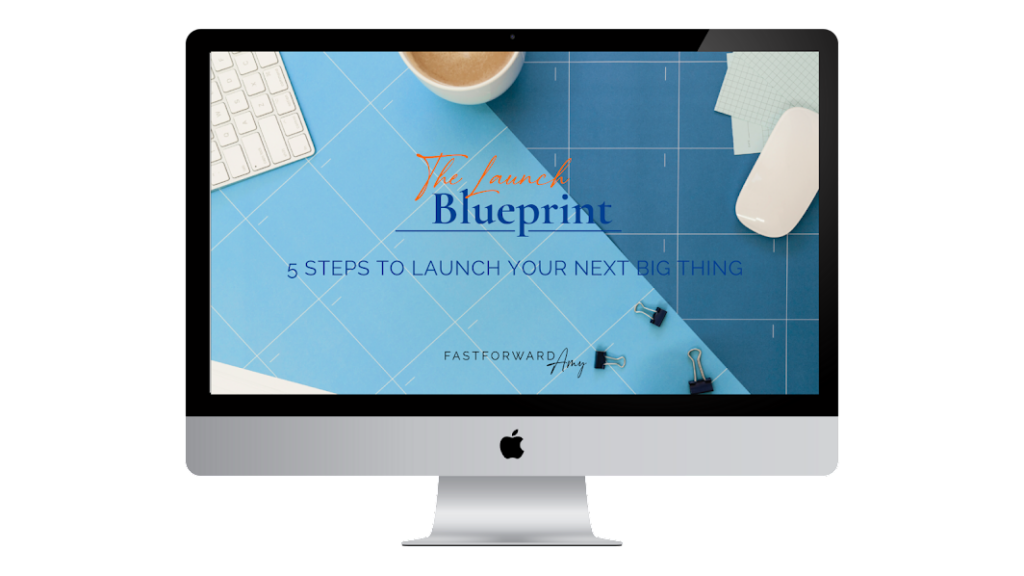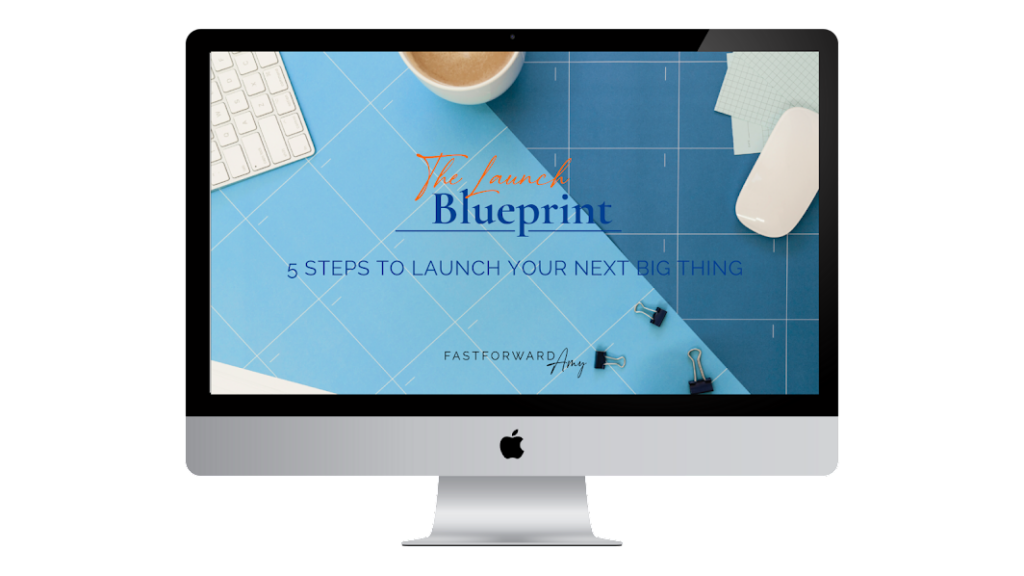To make money online, you need a great product, AND you need to sell your great product.
While it sounds relatively straightforward, several challenges often get in the way, and that's probably why a lot of people tend to get lost trying to create or sell a product.
If you're one of these people, stay put.
Launching a product or service can be extreme ly overwhelming. It's fair to say that it's easy to get stuck under a pile of work. I totally get it.
Today, I'll share with you how you can cut through the overwhelm of launching and selling your first offer, how to set up the correct timeline for your launch, and give you 5 non-negotiable key pointers you should remember at all times during any launch.
Listen on Apple: https://fastforwardamy.com/apple84
Listen on Spotify: https://fastforwardamy.com/spotify84
Listen on Google: https://fastforwardamy.com/google84
Let's dive right in, so we can get you set up for a successful launch.
1. Decide what you're offering
The very first thing you need to do is decide what you are offering or selling.
I assume you already have an idea of what you want to be selling, you know what your clients want, and you have a good idea about which price range you're going for.
If not, complete this first step, and check out episode 81 of the FastForwardAmy Show, where we talked about setting up your first (online) offer.
2. Pick a launch date
When are you launching? Put a date on it!
Commit to a launch date. If you don't, chances are you will never do it, and you will end up postponing the launch.
For instance, I postponed my podcast launch 3 TIMES before it became a reality. The reason: I never put it out there that it was launching; I didn't tell my audience about it.
An excellent way to hack yourself is to tell your surroundings what you're up to, as well as your audience. They will hold you accountable and ultimately help you make your launch a reality.
3. Select your milestones
It's time to decide on your milestones. Think of milestones like events you put in your calendar. They will happen, no matter what.
For instance, there's a difference between a birthday (which WILL happen) and you getting someone a present (which you have to do beforehand). The birthday is the milestone, whereas buying a gift is a deliverable to complete the milestone and make the birthday a success.
Looking towards your launch, milestone examples are:
- Launch doors open
- Price increase
- Launch doors close
Identify different milestones for your launch or sales process. Each of the milestones you select will make up the big picture timeline for your launch.
4. Identify deliverables for your milestones
I know what you're thinking: what's the difference between milestones and deliverables?
The deliverables are the action steps you need to complete to be prepared for your milestones. I have listed a few examples below.

Do you want more information about milestones and other launch knowhow? Join my free training The Launch Blueprint: 5 Steps to Launch Your Next Big Thing to learn all about launching: fastforwardamy.com/launchwebinar
Deliverable #1 Sales page
For instance, launch day is your milestone, while your deliverable is your sales page. A good tip: try to finish your sales page at least a week before launching your offer. Decide on a deadline and get it done.
Don't freak out about needing a fancy page with a crazy layout and all kinds of buttons. What you need is a page that convinces people about the value you offer and a way for them to check out.
Start with a simple Shopify sales page. It's easy to set up, and you don't need much; a photo of your product and a description will do the trick, for now.
Deliverable #2 Content plan
How are you going to promote the offer you're launching?
Your content plan is going to help you stay on track for the communication around your launch.
Keep in mind that deciding on WHEN you're going to communicate is not the same as WHAT you will communicate, namely the actual content.
In other words, your content plan and the content itself (like copy and visuals) are different deliverables.
Maybe you're also interested in this: Build your High-Converting Sales Funnel with these 5 Principles
Deliverable #3 Copy and visuals
What type of content will you use to promote your offer?
When we do a low-key launch, like a webinar or a flash sale, we typically have 3 core pieces of content that we send out to our email list, and you can use the same structure:
- Email #1: Announce the offer (what are the benefits and the transformation?)
- Email #2: Highlight features (how does the offer work, and what do clients get out of it?)
- Email #3: Include social proof (what do previous clients think about the offer?)
Based on these 3 emails, you can create 3 Instagram feed posts and 3 Instagram story posts. Suddenly, you will have 9 pieces of content to promote your launch.
That also means you have the chance to highlight your offer 9 times. People need to hear something 8-10 times before they register what's happening and take action.
These are all examples of deliverables. There's a ton of other things to keep in mind, but don't overcomplicate things. Start with what you have.
You're here to launch successfully, and that also means you have to put in the work.
Remember that the deliverables are not the same as doing the actual work. This is where most people get stuck under a mountain of work because they can't see through to the end anymore.
Structuring your work according to milestones and deliverables is going to help you get there. Step by step, you will work your way towards launch day, and BOOM, you're going to sell like crazy!
RECAP
When launching, use these 4 steps to set yourself up for success:
- Decide what you're offering
- Pick a launch date
- Select your milestones
- Identify deliverables for your milestones
Let's have a look at 5 other non-negotiable key pointers you should remember as you go through any of the steps above.
5 non-negotiable launch items
As you're getting to work, don't forget these 5 key items during any time of your launch.
#1 Hype it up
When you're promoting your offer, make sure you hype it up to people. Make them EXCITED about what's coming up.
At the time of launching my podcast, I didn't just go, “Hey everyone, here's my podcast.”
Instead, we created dedicated content around the podcast launch, and you should do the same with whatever you're launching.
Hyping it up is SO important. If you don't, people will not have any clue about what you're offering, and no one will take action and buy what you have to sell.
TIP: Adding extra incentives for people to take action fast is always a winner; for instance, you can add a bonus or a discount that people get if they buy within the first 24 hours. It's a great way to reward your fast action-takers.
#2 Be super transparent
During any launch, be super transparent about what you're offering.
For instance, don't tell your audience, “Something exciting is coming up.” No one cares about you having something exciting coming up; they care about themselves.
Talk about WHAT is coming up. Make it tangible.
That means
- talk about what you're launching (your actual offer),
- talk about the price, so people have time to rationalize themselves into buying from you,
- talk about who your offer is meant for.
Being transparent is also your filter to help sort through the right clients for you.
#3 Follow the timeline
No matter what's coming up, you must stick to your timeline.
Maybe you were planning to send out super fancy emails with a nice design, but you didn't have the time to create an epic layout. Or perhaps you wanted to make really nice slides for your webinar but left with no time to do it.
Don't sweat it. Just send out the email. Host a webinar without slides. The trick is to always follow the timeline, even when what you planned to do isn't perfect.
Once you have your decisions in place, take action on them every day and stick to your timeline.
TIP: focus on your 80/20. It's far better that you show up perfectly imperfect NOW than showing up perfectly later. Perfect doesn't exist anyway.
In the next phases of your launch, you can learn and improve, and that way, you'll be able to work iteratively.
#4 Lead with value, always
You want to sell, naturally, but don't constantly push through your offer.
Lead with value; share free tips, advise people.
For instance, let's say I have a webinar coming up on money management. Of course, I want people to register, but in between pushing the sale, I'm leading with value. That could mean giving away money mindset tips in one of the promotion emails.
There's always a time and place to push the sale and work through objections, but giving advice will increase your authority massively and ultimately help convince people that what you have to offer is worth it.
#5 Simplify
If your launch plan is beginning to look too complicated, it's not a good sign, and it's probably time you start simplifying whatever you're doing.
Have a look at your plan and simplify it; cut out what you can cut out, and keep the elements that are going to move the needle.
Remember, DONE is always better than perfect.
It's better to launch your offer now, learn from it, and relaunch it in a few months. Postponing your launch will not make you a winner.
Learn from taking action perfectly imperfect instead of postponing perfection.
Screenshot these 5 non-negotiable launch items and keep them with you at all times:
- Hype it up
- Be super transparent
- Follow the timeline
- Lead with value, always
- Simplify
That's it, and now it's your turn.
Go be a winner, take action. Good luck with your next launch!
Watch this episode on YouTube or listen via iTunes, Spotify, or wherever you get your podcasts, and search for episode 84 of The FastForwardAmy Show.
PS Check out my free training The Launch Blueprint: 5 Steps to Launch Your Next Big Thing to learn where and how to start planning your next or first successful launch. Register for FREE via this link: www.fastforwardamy.com/launchwebinar

We do not take any responsibility for the financial decisions or any other business-related decisions made by listeners/businesses based on our podcast content. Every business has its own specifics, which we cannot take into account in this podcast.

Leave a Reply